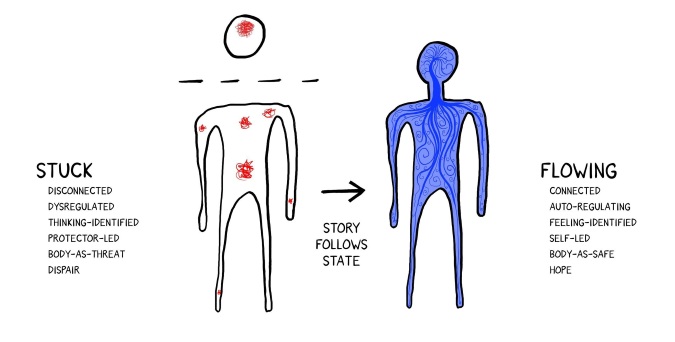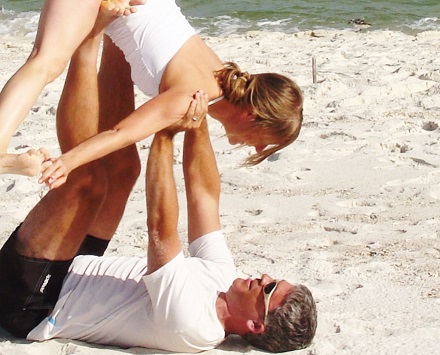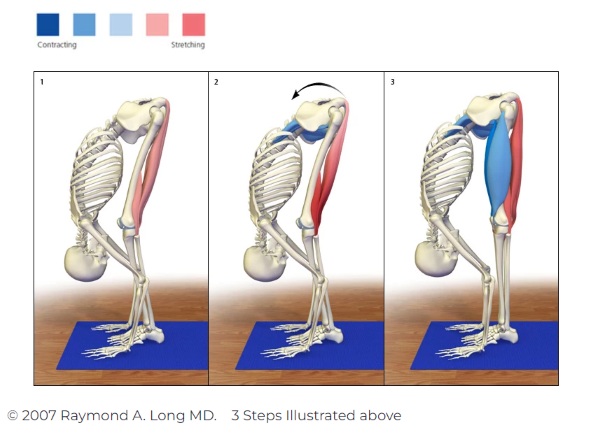


You know when you go round the table
and share what you're thankful for?
Sometimes it can seem like playacting,
especially if life doesn't feel awesome
at the moment. But there's something
to it, a scientific something in fact.
FMRI studies have uncovered a neural
consequence of thanksgiving.
Generating gratitude stimulates
the stress regulating hypothalamus and
activates the pleasure producing reward
circuitry in our brains.
It's also been proven that expressing
gratitude brings out the best in others.
It's hard to stay cranky when fully
experiencing, sharing, or receiving
the gratitude of another.
You know what I'm thankful for?
You.
Thank you for trusting me with your
sweet self on the mat each week.
My life would definitely be
less awesome without you.
xo Taunia

I recently heard Bessel van der Kolk
talk about his reading of Darwin
from whom he learned this:
The function of emotions is to move.
Movements are necessary to open up
and learn what's happening inside,
to grow, explore, adapt, and evolve.
Yoga is a wonderful container
for this sort of exploration.
See what comes up when
you're practicing.
Sensitize yourself to
messages from your body.
Our yoga practice has more
dimensions that we could
discover in a lifetime.
Let's practice this
together this week.

Authentic love is to understand
both strengths and weaknesses,
of yourself and others, and
accept them all. It is a dynamic
dance of give and take without
conditions, of letting go into
uncertainty and vulnerability,
and being willing to help that
person when needed.
-Anam Thubten
Oh, my goodness.
Talk about yoga off the mat.
Our personal relationships
provide steady ground
for good work.
What good is all this effort
to balance on one foot,
breathe skillfully, notice
reactivity to physical challenges,
and work for equanimity
if not for how to live
well in the world?
We'll meet our own strengths
and weaknesses in asana
practice this week.
Practicing how to be dynamic
and helpful to ourselves.
A good place to start.

One of the common areas of complaint
I hear from yogis is dissatisfaction with
their hamstrings. They're so recalcitrant!
Here's why you always hear me instruct
to bend the knees when heading into a
forward fold (uttanasana). We want to
keep the lower back safe and work with
the hamstrings intelligently. Rather than
goofing around simply hanging forward
and wondering why we feel so tight.
Refer to Dr. Long's illustrations above.
1- Bend knees to release hamstrings
where they connect to the lower legs.
2- TIlt the pelvis forward to stabilize
hamstrings at their origin point.
Remember how I often cue "tailbone
to sky - belly towards thighs?"
Note the psoas muscle contracting.
3- Only then might you consider
lengthening the legs if you like.
This involves contracting your quads.
That pelvic tilt is essential, so you
can be forward folding your life long.
We'll work on this together this week!

Our ordinary minds demand
an ordinary world and feel
at ease only when they have
explained and taken for granted
the mysteries among which we
have been given so short a
license to breathe. Imagine the
state of wonder that would
possess our spirits had we
been suddenly transported to
the earth from some planet
undisturbed by the urge of life.
-Llewelyn Powys (1884-1939)
How easy it is to slip into
unseeing. Digesting mysteries
as though commonplace.
Perspective is everything.
Beginner's mind over and over.
Caught by surprise at a vivid sky
or the manner in which you've
learned to move your body
with grace and strength in a
myriad of poses on a yoga mat.
You're something.
So is this world you
find yourself in.
Gasp every now and then.
Practice anew this week.

"In Vietnam there is a saying that
when the father eats too much salt,
the son has to drink a lot of water.
Karma, or action, is like that.
Not only do you have to suffer,
your children have to suffer also.
That is why to practice the precepts
is to protect yourself and to
protect future generations."
-Thich Nhat Hanh
Once I really grasped this concept,
I got serious about doing my
inner work. Looking at patterns,
especially the ones so ingrained
I almost couldn't see them.
God knows, I'll never ever
reach heights of complete
awareness in my family life,
but if I can be even a bit
more conscious, I'll leave
a lighter and softer legacy.
I've heard it said that
"The people we choose to become,
our children inherit."
Gulp.
You've heard of Swedish
death cleaning? You know,
when you try to get rid of your
physical detritus so your kids
aren't saddled with it all one day?
I think doing this on an emotional,
psychological level is far more
essential with more profound
benefits for not only those
who come behind us
but those around us now.
Yoga can support
this type of work.
Let's hone our awareness
on the yoga mat this week.

This poor fellow needs to
stand up straight in tadasana
and take 3 full body breaths
before he finishes his work.
Most of these ill effects from
poor computer posture are
probably old news to you. Yet,
I hadn't thought much about
adductor overuse. Holding
your legs close together or
habitually crossing them
leads over time to contracted
inner thigh muscles. That
tightness leads to imbalances
throughout the body.
And sleepy, amnesiac glutes
certainly don't help matters.
We want balanced strength
and suppleness throughout
our lower body. It's essential
to remain comfortable and
capable in our bodies.
There will be some happy baby
and chair poses in your future
should you practice with me
this week. I hope you will.

“The smartphone is a mobile labour camp
in which we voluntarily intern ourselves.”
-Byung-Chul Han
How does that strike you?
I've just recently discovered this
South Korean born German philosopher.
This pithy statement packs a punch, no?
Ouch. Feels itchy true to me.
In Non-Things, he says the glut
of information we are incessantly
imbibing online is slowly pulling
us away from real experience
with real objects and people
- real things. You know, where
you can sense the energies
of others you encounter, see
what's in their eyes, and enjoy
sensorial connection with all
you touch, smell, hear and taste.
Rising AI hopes to entice you otherwise.
Be a rebel.
Live on purpose in the real world
a bit more, and the ether a bit less.
Then feel the glorious possibility
your physical body holds when
you move it in space
-like on a yoga mat this week.

This smart green fellow who
showed up in my house
made me remember this
poem by Rudy Francisco.
Mercy
after Nikki Giovanni
She asks me to kill the spider.
Instead, I get the most
peaceful weapons I can find.
I take a cup and a napkin.
I catch the spider, put it outside
and allow it to walk away.
If I am ever caught in the wrong place
at the wrong time, just being alive
and not bothering anyone,
I hope I am greeted
with the same kind
of mercy.
I'm also reminded of the yogic
principle of ahimsa, non-violence.
Bring your merciful self
to the yoga mat this week.

"What better way to understand
a society's workings, I thought,
than to study what it forbids."
This, from anthropologist Manvir
Singh's new book Shamanism -
The Timeless Religion. If this topic
even slightly interests you, I
recommend this work for new
ways of understanding how
culture and religion adapt to
the contours of the human mind.
My borrowed copy will now be
in circulation again at the
Nashville Public Library.
But this anthropological lens
of noticing what you forbid
as a way to understand your own
inner workings fascinates me.
If I look back at my life in yoga,
I've had teachers with all sorts
of hard and fast rules that seemed
most interested in, well, control.
No free form expression allowed.
Conversely, I've had teachers for
whom yoga was all about freedom,
and I was told to embrace this
theme in almost every class though
for me, this had absolutely nothing
to do with why I was practicing.
If I look at my life's path in general
and all the very fervent ideas
I've held fast to, there's much
to glean from what I forbid in my
various phases of certainty.
I'm looking now, too, as I am
very much a work in progress.
And a messy one at that.
Try this lens for yourself.
And maybe notice if there's
anything you forbid yourself
in your yoga practice. Why?
Or, if you're brave, cast this
question wider into your life.
(It strikes me our country
could benefit from this type
of introspection just now.)
To each her own.
Come to yoga
to find what you need.
__________________
photo credit: Joshua Rondeau